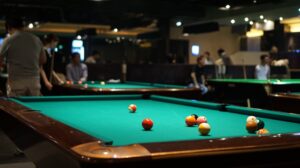When buying a pool table, you may not know where to start if you’re looking at a pool table on sale. The first thing you should know is what kind of pool tables are available – what are they made out of, what sizes are available, and the best size for the room you want to put them in. We’ll cover those topics in this article.
Table Types
You have a few different choices of pool table materials. Some materials are of better quality than others but cost more. Whatever you choose, make sure it fits your budget and your needs.
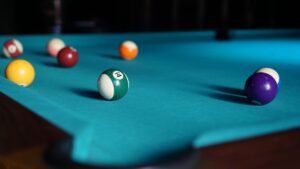
Synthetic Slate Tables
A synthetic slate looks like a slate, but it’s not a real slate.
MDF Particle Board
This material works initially but warps over time. The combination of condensation and temperature changes almost guarantees this table’s demise, and you can’t do much to protect it.
Typically used on low-end, inexpensive pool tables, you can also find it on higher-end tables that emphasize lightweight construction over durability.
Honeycomb
This honeycomb surface consists of layers of hardened plastic. Even though it doesn’t warp, the surface is rougher than other synthetics. They’re also lighter than traditional tables, and they become unstable when used with cabinets designed for economy.
Slatron
A layer of hardened and condensed plastic covers the particleboard. It is considered the best option and the most costly among the available synthetics. It’s great if you want quality but doesn’t want to commit to a long-term slate purchase.
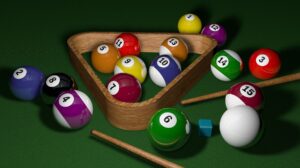

Pure Slate Tables
Slate is the best pool table material you can buy, so it gets its section in this article. It’s excellent for making pool tables because it provides a nice flat playing surface. It comes in ¾ inch, ⅞ inch, and 1-inch sizes.
The BCA recommends and approves one-inch slates for tournaments. It’s more expensive than other options, but there is a considerable payoff. Under normal circumstances, it doesn’t crack or warp, and the surface allows for a clean, smooth shot.
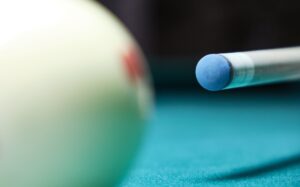

Pool Table Styles and Aesthetics
Pool tables are large and require a lot of maintenance. So, consider whether it complements your home or clashes with it. Modern and unique tables can go well with specific decors, but they need someone with a keen sense of style to ensure they match.
Moreover, a good table should last a few decades, so be conservative if there is any hesitation. There are three basic types of pool tables:
- Traditional: These tables are tried and true. They are the same tables your grandparents played on. They’re usually upholstered in green or red vintage felt, and their frames consist of hardwood. There is a pattern and style to the table legs similar to older chairs and tables.
- Contemporary: These tables incorporate a modern twist on an older design. Black polished hardwoods could be replaced with stained hardwoods, and patterned felts could replace green and red ones.
- Modern: Modern pool tables are completely different from ones of the past. Pedestals can replace table legs, other pocket arrangements, fabric colors, and glass LED top covers that highlight shot angles.
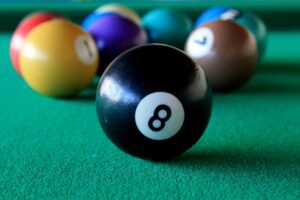

Sizing and Spacing
Before buying a pool table, you need to know how much room you have. Newcomers often underestimate their space requirements. When figuring out how much space you need, consider these things:
- How much space do you have on all sides of the table.
- The size of the cues you want to use
- Who will use the pool table
- Do you want a cabinet or rack for cue or ball storage?
A standard 8-foot table is considered professional size, whereas a 7-foot table is considered bar size. If the space permits, buyers usually choose the bigger size since it provides an improved playing experience.
Another consideration is that most bars use a 7-foot table. That means you will not only save space at home, but you will already be familiar with the size table used at bars.
Based on 57-inch pool cues, an 8-foot table requires about 14 feet by 18 feet of space. A seven-foot table requires about 13 feet by 17 feet. You can consider using a shorter pool cue if space is tight.
If you use it in the basement, watch out for beams that might obstruct play. Even if there are beams, there are ways to work around them:
- Place the table’s breaking end away from the support beam.
- To minimize the impact of a game, position the obstruction in the middle of a side rail.
- If there’s an obstruction for a regular shot, introduce “house rules” so you can reposition if necessary.
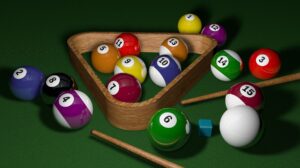

Table Size Room Calculations
According to Wikipedia, the minimum space for a pool table is the playing area plus the pool cue length, plus about six inches for the backswing. Based on this information, here are some rough room size calculations for different pool table sizes:
- 12 feet 9 inches by 16 feet for a 7-foot pool table (obtained from Legacy Billiards)
- 14 feet 4 inches by 18 feet for an 8-foot pool table with a 44 by 88-inch playing area
- 14 feet 10 inches by 19 feet for a 9-foot pool table with a 50 by 100-inch playing area.


Pricing a Pool Table on Sale
A pool table is a good investment, no matter how much you spend. You can easily spend more than $2,000 on an affordable slate table, the best option.
While you can buy a fun table for less, that’s an approximate budget for an investment in a table that’s a quality piece of furniture with a durable, high-quality playing surface.



Conclusion
That’s what you need to know about buying a pool table. As you look at a pool table on sale, consider how much you have to spend, how big the room is you want to put the table in, and how much you want to spend on other accessories such as pool cues and a rack.
Once you know what size pool table you want, how much you want to spend on the pool table, and the accessories that go with it, finding a pool table on sale that fits your budget will be easier.
